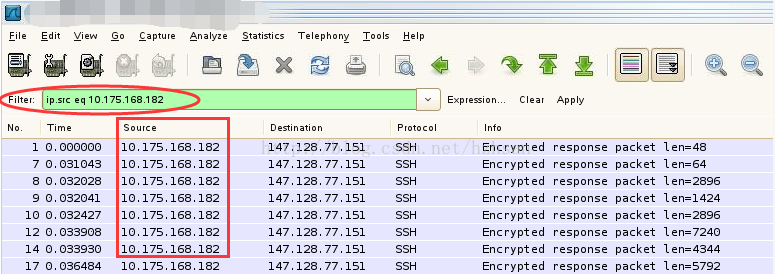wireshark基本用法及过虑规则
转自:http://blog.csdn.net/hzhsan/article/details/43453251
wireshark基本用法及过虑规则
Wireshark 基本语法,基本使用方法,及包过虑规则:
1.过滤IP,如来源IP或者目标IP等于某个IP
例子:
ip.src eq 192.168.1.107 or ip.dst eq 192.168.1.107
或者
ip.addr eq 192.168.1.107 // 都能显示来源IP和目标IP
linux上运行的wireshark图形窗口截图示例,其他过虑规则操作类似,不再截图。
ip.src eq 10.175.168.182
截图示例:

提示: 在Filter编辑框中,收入过虑规则时,如果语法有误,框会显红色,如正确,会是绿色。
2.过滤端口
例子:
tcp.port eq 80 // 不管端口是来源的还是目标的都显示
tcp.port == 80
tcp.port eq 2722
tcp.port eq 80 or udp.port eq 80
tcp.dstport == 80 // 只显tcp协议的目标端口80
tcp.srcport == 80 // 只显tcp协议的来源端口80
udp.port eq 15000
过滤端口范围
tcp.port >= 1 and tcp.port <= 80
3.过滤协议
例子:
tcp
udp
arp
icmp
http
smtp
ftp
dns
msnms
ip
ssl
oicq
bootp
等等
排除arp包,如
!arp
或者
not arp
4.过滤MAC
太以网头过滤
eth.dst == A0:00:00:04:C5:84 // 过滤目标mac
eth.src eq A0:00:00:04:C5:84 // 过滤来源mac
eth.dst==A0:00:00:04:C5:84
eth.dst==A0-00-00-04-C5-84
eth.addr eq A0:00:00:04:C5:84 // 过滤来源MAC和目标MAC都等于A0:00:00:04:C5:84的
less than 小于 < lt
小于等于 le
等于 eq
大于 gt
大于等于 ge
不等 ne
5.包长度过滤
例子:
udp.length == 26 这个长度是指udp本身固定长度8加上udp下面那块数据包之和
tcp.len >= 7 指的是ip数据包(tcp下面那块数据),不包括tcp本身
ip.len == 94 除了以太网头固定长度14,其它都算是ip.len,即从ip本身到最后
frame.len == 119 整个数据包长度,从eth开始到最后
eth —> ip or arp —> tcp or udp —> data
6.http模式过滤
例子:
http.request.method == “GET”
http.request.method == “POST”
http.request.uri == “/img/logo-edu.gif”
http contains “GET”
http contains “HTTP/1.”
// GET包
http.request.method == “GET” && http contains “Host: “
http.request.method == “GET” && http contains “User-Agent: “
// POST包
http.request.method == “POST” && http contains “Host: “
http.request.method == “POST” && http contains “User-Agent: “
// 响应包
http contains “HTTP/1.1 200 OK” && http contains “Content-Type: “
http contains “HTTP/1.0 200 OK” && http contains “Content-Type: “
一定包含如下
Content-Type:
7.TCP参数过滤
tcp.flags 显示包含TCP标志的封包。
tcp.flags.syn == 0x02 显示包含TCP SYN标志的封包。
tcp.window_size == 0 && tcp.flags.reset != 1
8.包内容过滤
-----------------------------------------------
tcp[20]表示从20开始,取1个字符
tcp[20:]表示从20开始,取1个字符以上
注: 些两虚线中的内容在我的wireshark(linux)上测试未通过。
--------------------------------------------------
tcp[20:8]表示从20开始,取8个字符
tcp[offset,n]
udp[8:3]==81:60:03 // 偏移8个bytes,再取3个数,是否与==后面的数据相等?
udp[8:1]==32 如果我猜的没有错的话,应该是udp[offset:截取个数]=nValue
eth.addr[0:3]==00:06:5B
例子:
判断upd下面那块数据包前三个是否等于0x20 0x21 0x22
我们都知道udp固定长度为8
udp[8:3]==20:21:22
判断tcp那块数据包前三个是否等于0x20 0x21 0x22
tcp一般情况下,长度为20,但也有不是20的时候
tcp[8:3]==20:21:22
如果想得到最准确的,应该先知道tcp长度
matches(匹配)和contains(包含某字符串)语法
ip.src==192.168.1.107 and udp[8:5] matches “\\x02\\x12\\x21\\x00\\x22″ ------???--------
ip.src==192.168.1.107 and udp contains 02:12:21:00:22
ip.src==192.168.1.107 and tcp contains “GET”
udp contains 7c:7c:7d:7d 匹配payload中含有0x7c7c7d7d的UDP数据包,不一定是从第一字节匹配。



